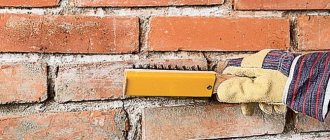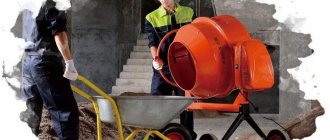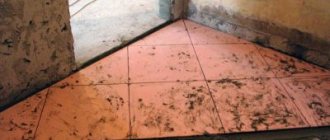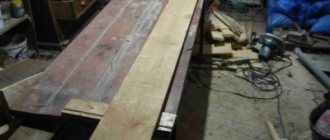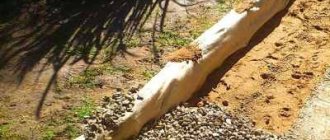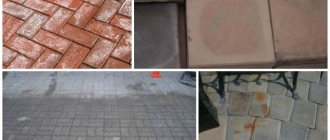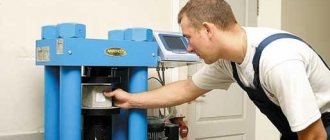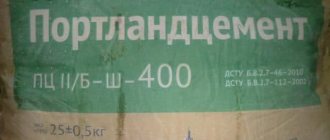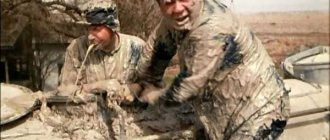Cleaning methods
Basically, cleansing is a mechanical process, often using tools, which requires a certain amount of physical strength. But there is also chemical washing - with acids or other liquids. Everyone chooses what suits them best when deciding how to clean a concrete mixer and not damage it during this rather tough process.
1. By adding crushed stone to the drum. The method is that the concrete mixer cleans itself. You need to pour a little water into the bowl, about 3 liters, and then fill the buckets with two small crushed stones or gravel. And turn on the equipment. The obedient concrete mixer begins to “wash itself.” She quickly stirs the abrasive mass with blades, and small stones knock on the cement, breaking it and cleaning it off. Thus, it is very easy to clean the concrete mixer from concrete, and no additional tools are needed. The process takes 10 minutes. I have given you the proportions for an average mixer, which is most often used for household work - 120-130 liters. If the drum is larger in volume, then you also need crushed stones, plus another bucket or half a bucket. For each bucket - 0.75 liters of water - an incomplete liter jar. In general, be guided by your sizes. After all, the essence of the washing process with crushed stone is that the mass should reach the edges so as not to leave them dirty. After the procedure, the mass is poured out. If necessary, repeat, no big deal, and then use a hose to rinse the inside thoroughly. Once it dries, it will be clean and beautiful.
2. Using a shovel
The ancient way to clean a concrete mixer, by the way, is the simplest and quite common. The shovel is sharpened at the edge; it is used to carefully scrape off the remaining mixture. Fresh removes well, frozen - worse. When scraping frozen mass from the blades, there is a risk of damaging them. And the inner walls of the bowl are not happy when they are scraped so hard with sharp metal. Damage can affect the quality of the mortar in the future, so the “old-fashioned” method - scraping, I do not recommend for dried cement.
3. Using a chisel and hammer
Both the previous and this method of cleaning a concrete mixer are harsh and violent. It's like using a knife to scrape off frozen ice in the freezer. Anything wrong - and the freon goes away forever. Your stirrer can also “go into oblivion” if you chop its walls with great force. Well, maybe it won’t break, but it will be deformed - that’s for sure. Therefore, I advise such processes to be carried out only in exceptional cases - if nothing else is acceptable.
4. Using a grinder with a brush attachment . This method may be very effective, but at the same time it is very harmful to the surface of the unit. To perform this work, you need to buy a special attachment for an angle grinder, such as a wire brush. And also be patient. After all, if a chisel and hammer vigorously crush hardened cement and wash the crushed stone for about 10 minutes, then you need to clean it with a grinder for half an hour to an hour, and even intermittently. It resembles grinding, and the operating time depends on the size of the drum. Also wear gloves and safety glasses (a mask), because during this procedure small fragments and dust fly in different directions.
5. Using hydrochloric acid And this method does not require physical strength, but the ability to deal with caustic chemicals. In this case I mean hydrochloric acid. A very strong and dangerous thing, but it corrodes cement perfectly. The solution should not be strong, not lower than 5 percent, the most effective is 10 percent. Buying it is not so easy, you need to know where to get it, and after washing you must get rid of the residue, which is also quite difficult. But the use itself is simple: pour it into the drum, turn it on, swirl it a little. Don't forget to wear gloves, because acid can cause skin burns. Drain. Then you still need to rinse with soda. Then use clean water from a hose. It turns out gentle and neat. By the way, during any cleaning, remember that you need to wash the cement mixer from the outside. After all, equipment always gets dirty on both sides. Acid will not work on the outer walls, gravel will either, no shovels or chisels are needed. It is best to use clean water under pressure. If necessary, use sandpaper. This is another and popular way.
How to clean hardened cement from a concrete mixer?
When carrying out repair and construction work, the problem of hardened cement mortar sticking to tools and equipment often arises. Accumulated deposits impair operation and eventually lead to equipment failure. Let's look at what needs to be done to clean the concrete mixer from the solution.
Mechanical cleaning is considered the most common method. When carrying out work, it is important to be careful to avoid damaging the drum and gear of the concrete mixer. The following methods are most often used.
- Mortar deposits stuck to the inner surface can be easily removed using crushed stone. Fine gravel is poured into the thicket, water is added at the rate of 1 liter per bucket of crushed stone and turned on. When the blades rotate, the mass breaks up and removes the deposited layer. Using the method does not require physical effort, the main thing is to calculate the volume of substances used.
- In the case of a large accumulation, the mixture is initially softened with water, then broken into pieces with a bayonet shovel. Sagging on the walls or neck is scraped off. The disadvantage of this method is the inability to clean small parts.
- Large pieces of frozen mass are removed by chipping using a chisel and hammer. Such cleaning requires physical strength, attentiveness, and caution.
- When a thick layer of frozen mortar forms, it is rational to use a grinder with a special brush attachment. The method is gentle, quite effective, but takes a lot of time.
- Using a metal brush, remove minor deposits and frozen drops of concrete. This method is excellent for cleaning gaps and mechanism parts.
After cleaning, the equipment is washed with water from a hose and then dried.
When working with a grinder or a wire brush, safety precautions must be observed. To avoid injury and dust, it is recommended to wear gloves, safety glasses, and a respirator.
Using water
The hydrotreating method is considered one of the most effective and safe. To clean the concrete mixer from hardened cement, use Karcher high-pressure mini washers or similar ones.
The water jet is supplied under pressure from 180 to 280 Bar.
The special “mud cutter” attachment included in the kit, designed to remove hard, old deposits, greatly simplifies the process.
Thanks to the rotary design of the nozzle, the rotating jet of water “cuts off” even dense deposits. When using, it is worth considering that intense exposure can cause harm to the surface being treated. To break up cement stone or clean hard-to-reach mechanisms, use a point nozzle.
Methods that use specialized chemicals that dissolve cement mixtures are also considered effective. The composition of the products includes complex acids and inhibitors to protect the surface.
After application, the active substances dissolve the cement layer, the influx softens and is washed off with water. They are produced in the form of concentrates, which for use are diluted with water in the specified proportions.
When choosing, you should consider:
- type of surface to be cleaned;
- degree of oldness of sediments;
- method of application.
The following products are considered the best, which are used for various types of surfaces - metal walls of a concrete mixer, formwork, tiles.
Barracuda 10K is a concentrated synthetic acid-based concrete solvent. It is recognized as one of the practical compositions for cleaning surfaces made of metal, ceramics, wood, glass, and plastic.
Quickly removes plaque on concrete mixers, mixers, and tools. The drug is effective in the cold season. Produced in canisters of 1.10 liters.
Sopro ZSE 718 is a product for delicate removal of cement residues from hand and power tools, tiles, tiles, and natural stone. It has a mild odor and can be used in enclosed spaces. Available in 1 liter canisters.
Prosept Cement Cleaner cement remover is a highly effective chemical. a preparation for cleaning tools, building materials against cement mortar, concrete splashes, efflorescence. In undiluted form, it is able to remove old plaque from any surface. Widely used for cleaning after construction work. Packaged in 1 and 5 liter containers.
It is important to observe safety precautions when using chemically active solvents. To avoid acid contact with the skin, be sure to wear gloves when carrying out cleaning work.
To prevent the formation of mortar overflows on the walls of the concrete mixer, the sequence of loading the components should be observed. If the sequence is violated, concrete sticking initially occurs. Along with the cooking technique, experts recommend treating the inner surface with a special release agent.
Automotive anti-corrosion coating Antikor or liquid silicone for processing molds for filling are also suitable for these purposes. One impregnation is enough for 2 months of uninterrupted operation. Then the coverage needs to be updated.
Experts advise spraying the working bowl with a strong pressure of water from a hose immediately after unloading and mixing the next batch using the water from the rinsing. Before each break and at the end of the working day, the concrete mixer is thoroughly washed with a brush and the water is drained. Such prevention methods will protect against concrete deposits and labor-intensive cleaning in the future.
During any construction, concrete is used, the preparation of which requires a concrete mixer. This device is indispensable if the cement composition is not purchased ready-made, but is mixed independently.
But after several uses, a layer of mixture sticks to its inner surface, which is difficult to remove. This occurs due to errors in concrete mixing technology, as well as due to lack of mixing.
To clean a concrete mixer from dried mixture, mechanical or chemical methods are used.
Physical impact is considered the most popular and widespread method for cleaning a concrete mixer. In modern construction, the following methods are most often used.
We suggest you familiarize yourself with How to remove tape and wipe off glue (traces) from tape quickly and effectively
Using crushed stone
When using this method, no mechanical action is required; the concrete mixer cleans itself.
About 3 liters of water are poured into the bowl, and then two buckets of fine crushed stone or gravel are poured.
The device then turns on and begins to rotate.
Using the blades of a concrete mixer, an abrasive mass is mixed, which can break up and clean off the cement layer.
This method allows you to clean the concrete mixer without the use of additional equipment. The whole process lasts about 10 minutes.
If the container is much larger, you need to increase the amount of crushed stone by adding another bucket (or half a bucket). 0.75 liters of water is poured into each bucket of crushed stone.
The essence of this process is that when mixing, the abrasive mass reaches the very edges of the bowl, then they will not remain dirty. Therefore, you should not save on crushed stone.
After the procedure is completed, the remaining mass is drained. If necessary, the entire process is repeated. Then you can thoroughly rinse the concrete mixer with a hose. After completing the procedure, the device is completely ready for new concrete mixing.
To use this method, you will have to purchase a special attachment in the form of a metal brush from the store.
This method is considered quite gentle; during its use, only the paint on the inner surface of the unit may be damaged.
But the method also has a significant disadvantage. To completely clean the device from the frozen solution, it will take about 30-60 minutes. In addition, you will have to take breaks. The speed of work also depends on the size of the concrete mixer. According to the principle of use, the method is similar to grinding the material.
Important! It is recommended to wear safety glasses (mask) and gloves during cleaning. During the procedure, small fragments of cement and dust fly in all directions, so ignoring safety precautions can lead to injury.
Chisel and hammer
These tools can be easily found in any home. The method of their use involves the application of physical force, because to clean you will have to knock the composition off the walls of the device.
The method is not recommended for use on dried concrete, since the tools can scratch the drum or deform it. Using a chisel with a hammer cannot ensure perfect surface cleaning.
It is recommended to use the method only if other methods do not help.
With a shovel
This method can be considered the oldest and simplest; it is most often used in everyday life.
The shovel has a pointed edge; it is convenient for cleaning off the remaining concrete mixture from the inner surface of the bowl.
Fresh composition can be removed well, but with frozen composition you will have to work hard.
Using a shovel to scrape the blades of a device with dried cement is not a good idea. They are very easy to damage, and this can significantly affect the quality of future concrete mixtures. And the walls of the bowl don’t like it when sharp metal is driven across them. Therefore, this method is not recommended for use on dried mixtures.
Using sand
Inside the drum of the concrete mixer, you should prepare a mixture of water and sand so that its consistency resembles liquid porridge.
The amount of this composition varies depending on the size of the bowl of the device. The principle of operation is almost the same as when using crushed stone.
Water helps soften the concrete composition on the walls of the concrete mixer, and sand will help wash it off due to its abrasive properties.
After this, the device turns off and the dirty water is poured out (it is better not to touch the sand).
Additional cleaning options
1. Mixture of sand and water
A sand-water mixture can also wash a concrete mixer of dried cement. After all, in fact, sand is the smallest abrasive, so it breaks up cemented residues well. A little longer than crushed stone, but in principle no less effective. The solution is made as with crushed stone - about half a liter of water per bucket of sand. Turn it on and crank it up. I personally like both sand and crushed stone, and most importantly, cleaning is easy, and the necessary materials are at hand. And the internal parts and mechanisms do not suffer. And one more thing - there is no need to throw away sand and gravel; they can be used for mixing concrete.
2. Emery cloth
It can also be used, but provided that there are small concrete pellets (hardened concrete) on the walls of the concrete mixer. In this case, they can be easily removed without damaging the surface of the device.
3. Cleaning products
In addition to the hydrochloric acid I mentioned, there are other chemicals. Their advantage is that they are sold everywhere, there is no need to “get” them, and disposal is specified in the instructions. It also describes how to cook and how much to pour. The process is short, no physical strength is needed, the drum is made like new. The downside is that it’s a waste of money, because special cement-dissolving components are not cheap.
Tips: how to protect yourself from sticking while mixing the solution
In principle, if you follow the consistency when kneading, then there should not be much sticking to the blades. I already wrote earlier in an article about how to properly mix concrete and emphasized that you first need to pour water. And then pour in cement, crushed stone and sand. This partially protects the blades from severe contamination.
But besides following the cooking instructions, there are a couple more secrets that I willingly share with you:
- Sprinkle some diesel fuel on the inside of the container. But overdo it - just a little, just so that it sticks less to the wall. If there is a lot, then the quality of the solution and the speed of its hardening will decrease.
- Diesel fuel is just that, traditional methods. And, in fact, there are special chemicals to prevent the mixture from sticking to the drum and blades. Such chemistry comes in different concentrations. Some are ready for use, others need to be diluted with water. If the solutions are ready, they are sprayed using a spray bottle. Spray the entire bowl and fan inside. There are also those who pour it into the drum, add water, and turn on the concrete mixer for 15-20 minutes. Be that as it may, such products work very well. After them, cleaning the drum is not difficult. Just read the instructions carefully
- I often see advice online - lubricate the gears with oil, they say, so cement and sand will not stick to them. I am against this method - lubricated blades, on the contrary, attract sand. And instead of lubricant, the mechanism receives an abrasive mixture, which accelerates the wear of the rubbing elements.
How to clean hardened cement from a concrete mixer?
An electric apparatus for mixing dry building components from which the mortar is made is called a concrete mixer. This invention is indispensable when laying concrete and facilitates the physical labor of workers. The machine mixes all the components of the mortar in the required proportions and brings them to the optimal consistency. The device also has a second name - concrete mixer. It is used by both private craftsmen and large contracting organizations.
To understand why it is necessary to clean the equipment immediately after use, you need to have an understanding of how a concrete mixer works. All its main parts are involved in the work. These include:
- drum with blades installed inside;
- traverse;
- frame;
- swivel mechanism;
- retainer;
- mechanical and electrical parts.
Small crushed stone, sand and cement are manually placed into the drum. These dry components of the future solution are mixed with water. The peculiarity of using a concrete mixer is that the building material must be prepared in the prescribed sequence, otherwise the solution will quickly harden and it will be difficult to clean the machine.
After the liquid concrete is ready, it is poured into the hole in the drum under its own weight. During this period of work with the device, it is necessary to ensure that all contents are removed from the concrete mixer. If some of the solution remains in the drum, it will harden and will prevent further operation of the device, blocking the blades.
During operation, a small amount of the mixture is sprayed when the container with the components that make up the concrete is turned. The solution sticks to parts of the drum, hardens and blocks the adjustment mechanisms.
Therefore, it is necessary to follow the rules for operating a concrete mixer during the preparation of the building mixture. It is recommended to place all dry ingredients in the drum in a strictly established order.
The machine must not be stopped for a long time until the work is completed. After the concrete is ready, the inner and outer surfaces of the drum should be thoroughly cleaned of adhering mortar residues. If the concrete has hardened, this will be more difficult to do. However, there are several proven ways to get rid of construction mixture stuck to equipment.
Construction equipment that allows you to mix dry components of a cement mixture will last much longer if it is used correctly. Each owner of a concrete mixer cleans it regularly; cleaned parts of the device wear out more slowly and allow you to obtain a high-quality solution on time.
There are several ways to remove hardened cement mixture:
- mechanical;
- chemical;
- hydraulic.
The choice of method for cleaning the concrete mixer drum remains with the builder, who constantly operates the equipment.
We invite you to familiarize yourself with Chicken stomachs value
Mechanical method
The simplest, but most labor-intensive way to clean a drum if concrete has hardened in a concrete mixer involves mechanical action on pieces of the hardened mass. They are simply knocked down with a chisel or bayonet shovel. With this tool and a hammer, large pieces of cement are broken off from the inside.
This method requires physical strength and endurance from a person. Its main disadvantage is not only that cleaning the concrete mixer is difficult and time-consuming, but also that it is impossible to completely remove the frozen mixture from small parts. In addition, the inner surface of the drum may be damaged.
Sometimes a grinder is used to clean a concrete mixer. A special brush is attached to one end of it, which evenly removes hardened concrete. The cleaning process is long and labor-intensive. The procedure should be carried out in a respirator, safety glasses and gloves, since cement dust is harmful to the human body.
You can pour crushed stone, sand or other abrasives into the drum, pour water and turn on the device for 10-15 minutes. The concrete mixer chamber should be installed so that the prepared mixture gets into hard-to-reach places with hardened cement. Then the drum is washed with water, after which the procedure is repeated.
Chemical
The fastest and most effective way to clean a concrete mixer from hardened mortar residues is to use construction chemicals. There are many professional products on the market that can dissolve cement within a short period. Their advantage is that industrial products do not damage the surface of various parts of the concrete mixer, even if they get on plastic elements.
The most popular chemicals are brands such as:
- "Barracuda";
- "Lugato";
- "Khimfrez";
- "Divinol Mischerschutz Spezial";
- "Bio Decap Concrete Guard".
Some of these cleaning products contain acid, so please read the instructions carefully and take precautions before using them.
At home, a weak solution of hydrochloric acid is sometimes used. The substance is poured into the drum, the device is turned on for 10 minutes, then the chemical compound is neutralized with water. The same principle applies to phosphoric acid or salt solution. When chemically cleaning a concrete mixer, wear gloves, protective clothing and goggles.
Acetic acid can also be used as a means to get rid of hardened concrete. This is an inexpensive and accessible substance. When working with it, you should follow safety precautions.
conclusions
Cleaning a concrete mixer from hardened concrete is a complex and time-consuming process. It is better not to waste time and clean the solution while it is fresh. You need to wash both inside and outside. It is convenient to use a hose outside. And in case of internal hardening, choose one of the methods:
- self-washing with crushed stone or sand. Effective, uncomplicated and profitable, because you already have these materials, and then they will go into concrete;
- tools - shovel, chisel, chisel. Tough and unpredictable for a concrete mixer. It is also labor-intensive and stressful for the user. As for “cheap and cheerful,” as many builders believe, I wouldn’t say so. It is possible that you will have to repair the mixer or buy a new one. Where is “cheap” here?
- What's cheap is sandpaper. And the instrument does not suffer. But it takes too long to clean the blades carefully;
- a good way is with a grinder with a special brush attachment (but it can just as well damage the surface);
- An effective option is the use of chemistry. If hydrochloric acid is not found, buy special washing solutions. The concrete mixer will shine like new.
So that cleaning is not so difficult, do the kneading correctly (water first). Better yet, spray the walls of the bowl and blades with a special solution so that the cement mixture does not stick to them. Then cleaning after use will be easy.
